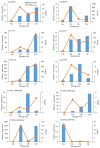Identification and Characterization of Long Non-Coding RNAs: Implicating Insights into Their Regulatory Role in Kiwifruit Ripening and Softening during Low-Temperature Storage
- PMID: 36903929
- PMCID: PMC10005093
- DOI: 10.3390/plants12051070
Identification and Characterization of Long Non-Coding RNAs: Implicating Insights into Their Regulatory Role in Kiwifruit Ripening and Softening during Low-Temperature Storage
Abstract
Long non-coding RNAs (lncRNAs) are crucial players regulating many biological processes in plants. However, limited knowledge is available regarding their roles in kiwifruit ripening and softening. In this study, using lncRNA-seq technology, 591 differentially expressed (DE) lncRNAs (DELs) and 3107 DE genes (DEGs) were identified from kiwifruit stored at 4 °C for 1, 2, and 3 weeks in comparison with non-treated control fruits. Of note, 645 DEGs were predicted to be targets of DELs (DEGTLs), including some DE protein-coding genes (such as β-amylase and pectinesterase). DEGTL-based GO enrichment analysis revealed that these genes were significantly enriched in cell wall modification and pectinesterase activity in 1 W vs. CK and 3 W vs. CK, which might be closely related to the fruit softening during low-temperature storage. Moreover, KEGG enrichment analysis revealed that DEGTLs were significantly associated with starch and sucrose metabolism. Our study revealed that lncRNAs play critical regulatory roles in kiwifruit ripening and softening under low-temperature storage, mainly by mediating the expression of starch and sucrose metabolism and cell wall modification related genes.
Keywords: fruit ripening and softening; kiwifruit; lncRNA-mRNA interaction; long non-coding RNA; low-temperature storage.
Conflict of interest statement
The authors declare no conflict of interest.
Figures







References
-
- McDonald B., Harman J.E. Controlled-atmosphere storage of kiwifruit. I. Effect on fruit firmness and storage life. Sci. Hortic. 1982;17:113–123. doi: 10.1016/0304-4238(82)90003-6. - DOI
-
- Paterson V.J., Macrae E.A., Young H. Relationships between sensory properties and chemical composition of kiwifruit (Actinidia deliciosa) J. Sci. Food Agric. 1991;57:235–251. doi: 10.1002/jsfa.2740570208. - DOI
-
- Ainalidou A., Tanou G., Belghazi M., Samiotaki M., Diamantidis G., Molassiotis A., Karamanoli K. Integrated analysis of metabolites and proteins reveal aspects of the tissue-specific function of synthetic cytokinin in kiwifruit development and ripening. J. Proteom. 2016;143:318–333. doi: 10.1016/j.jprot.2016.02.013. - DOI - PubMed
-
- Minas I.S., Vicente A.R., Dhanapal A.P., Manganaris G.A., Goulas V., Vasilakakis M., Crisosto C.H., Molassiotis A. Ozone-induced kiwifruit ripening delay is mediated by ethylene biosynthesis inhibition and cell wall dismantling regulation. Plant Sci. 2014;229:76–85. doi: 10.1016/j.plantsci.2014.08.016. - DOI - PubMed
Grants and funding
- XTCXGC2021006/the Collaborative Innovation Project from the People's Government of Fujian Province & Chi-nese Academy of Agricultural Sciences
- CXTD2021009-2/the Project of Fujian Academy of Agricultural Sciences
- ZYBHDWZX202206/the Project of Construction of Deciduous Fruit Tree Germplasm Resource Nursery of Fujian
- zycxny2021010-3/the Project of Seed Industry Innovation and Industrialization of Fujian
LinkOut - more resources
Full Text Sources
Research Materials

